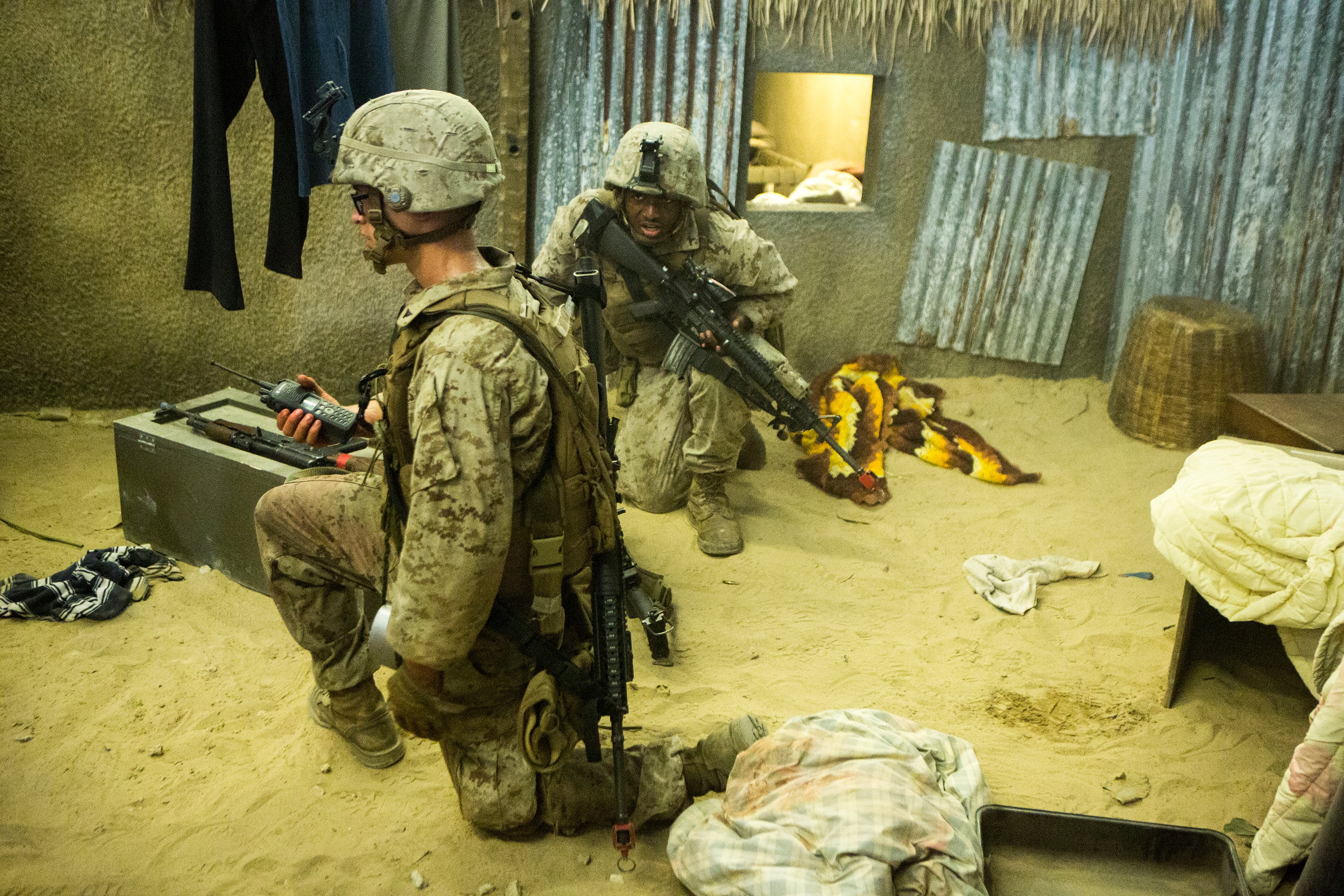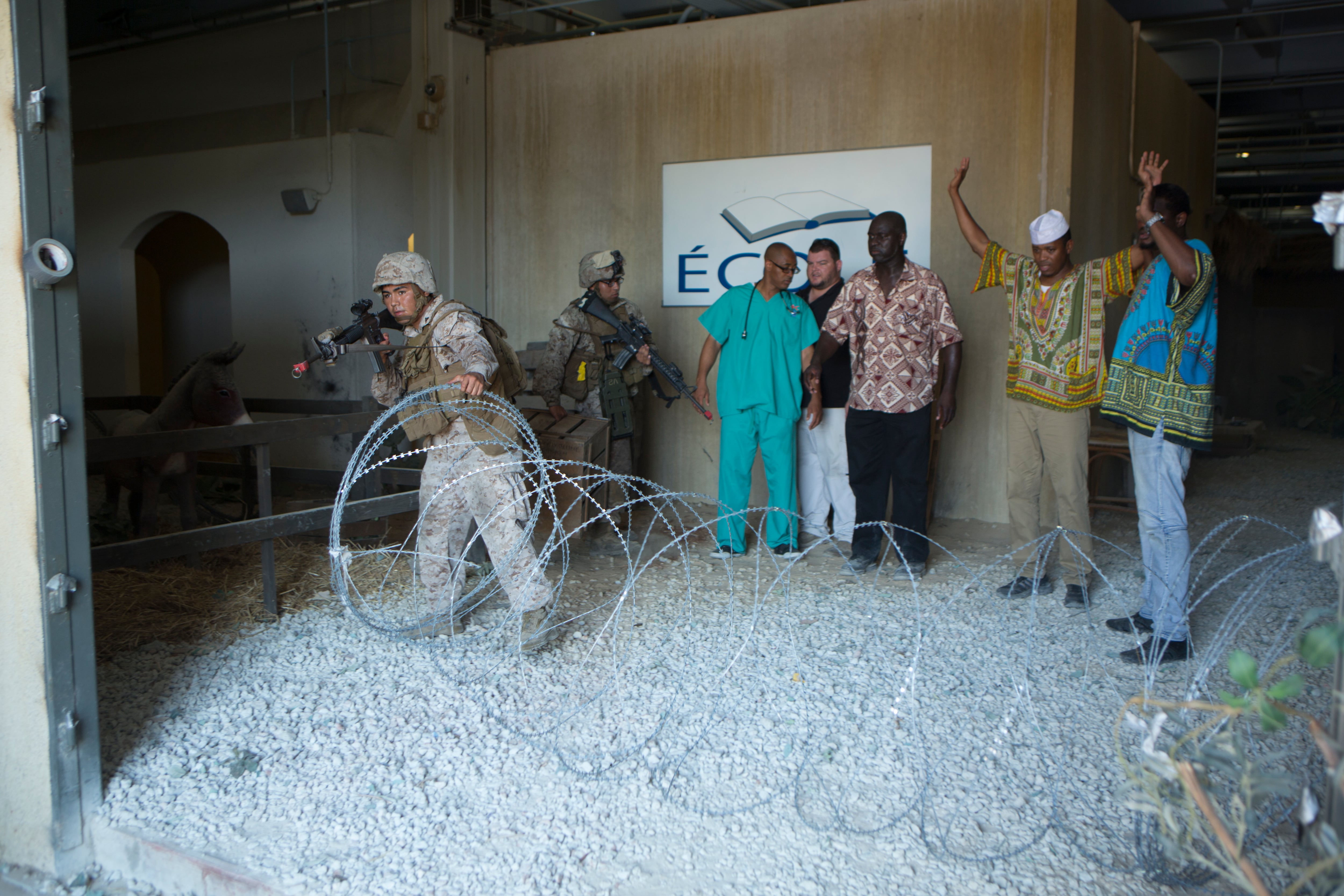One of the Marine Corps' A year ago, Camp Lejeune's warehouse-like infantry immersion trainers A Marine Corps infantry immersion trainer that once housed a simulated Afghan village, complete with piped-in prayer calls and the scent of sizzling lamb, now holds the mud huts of a Western African townhas gotten a makeover to resemble a West African town with new Today, the same warehouse-like complex is home to a realistic Western African town with new sights, sounds, smells and challenges for the Marines who come to visit.
The Lejeune's realistic trainer at Camp Lejeune, North Carolina, received its Africa makeover about four months ago, in time to host troops from 2nd Combat Engineer Battalion, who are training for an upcoming Marine expeditionary unit deployment. The North Carolina base also supplies troops for the Marines' crisis response task force for Africa, making the trainer reconfiguration a timely and practical pivot from missions focused on the Middle East.
That unit, the Spain-based Special Purpose Marine Air-Ground Task Force Crisis Response-Africa, is set to spend more time on the continent. Marine Task force officials have announced plans to have Marines with the unit visit austere cooperative security locations in Niger, Senegal and Ghana every six months, where they'll to train and build relationships in advance of future crisis response missions.
The administrators of the Corps' immersion trainers say the new layout at Camp Lejeune, which is subject to change based on the requirements of commanders at II Marine Expeditionary Force and 2nd Marine Division, demonstrates the flexibility of the system to adapt to current training needs.
"The [trainer] can be configured to resemble essentially any theater of operations," said Jack Cuddy, branch head for range and training area management at Training and Education Command. "This one just happens by chance to be West Africa, but it can be just about any scenario."
The trainer doesn't mimic one specific country by design. The administrators said a more generic Western African setting would give units and commanders more flexibility to use the trainer for a range of training missions and scenarios.
The most time-intensive part of the process, Cuddy said, was the research that went into making the new trainer configuration as realistic and authentic as possible. Contractors spent months researching signs age, authentic smells, and furnishings for African mud huts. They also researched even the level of foot and vehicle traffic needed to create a true-to-life village scene. Contracted African role-players, including a village chief, enemy forces, and civilians bring the detailed environment to life.
"You don't want to confront an okra when you should confront a cantaloupe," said Nick Klaus, range requirements section head for TECOM. "What type of clothing is hanging on the wash lines, what is it made out of? That's the kind of detail that [immersion trainer support personnel are] going into."

Marines with Bravo Company, 2nd Combat Engineer Battalion, communicate to the rest of their platoon during the Infantry Immersion Trainer on June 17 at Camp Lejeune, N.C.
Photo Credit: Lance Cpl. Aaron Fiala/Marine Corps
Inside the trainer, squad-sized Marine elements encounter a complex set of scenarios that blend traditional combat infantry tasks with humanitarian and crisis response challenges.
Lance Cpl. Steven Olivas, a fire team leader with 2nd CEB, said his element was tasked with entering the village to look for a high-value target and to investigate reports of improvised explosive devices in the area. They later had to secure and hold a government building in the village while waiting for reinforcements and communicate and coordinate with the village chief.
They would also be tasked with responding to rioting civilians in the town, care for and treat wounded villagers, and later conduct a simulated air evacuation of an injured wounded Marine. At one point, the Marines learned their security protocols were keeping local farmers and merchants from reaching the village marketplace, and had to take time to communicate with them and work out a solution.
For Olivas, who has never previously deployed, the trainer is as close to the real thing as he is going to get until his unit departs with the 22nd MEU next year summer.
"The Marines in the platoon, they feel confident now, they're always talking about it," he said. "The more training we do while we prepare for our deployment, keeping us on the edge, would probably be the best thing."
Another fire team leader, Lance Cpl. Timothy Dupuis, said the painstaking realism and chaotic environment inside the trainer had the intended disorienting effect.
"It was hard," he said. "It was really hot in there, like it would be in Africa. It smelled like another country, and there was dirt on the floors."

Marines with Bravo Company, 2nd Combat Engineer Battalion, remove a barrier during the Infantry Immersion Trainer on June 17 at Camp Lejeune, N.C.
Photo Credit: Lance Cpl. Aaron Fiala/Marine Corps
It's not clear whether the trainer will remain in an African village configuration long-term. With an increased regional focus for deployments, Cuddy and Klaus said the Marines' Hawaii infantry immersion trainer is getting made over to resemble a Pacific village. With Africa-focused missions at the forefront for East Coast troops, the new configuration would dovetail with upcoming deployments. However, they said, those decisions are made at the MEF and division level.
One thing is clear: more troops will be taking advantage of the trainer as a predeployment prerequisite. First 1st Lt. John McCombs, a II MEF spokesman, said 2nd Marine Division commander Maj. Gen. Brian Beaudreault had given first priority to units deploying with crisis response units or MEUs on SP-MAGTF and MEU missions.
The commandant, Gen. Joseph Dunford, mentioned the trainers specifically in his planning guidance, released in January.
"We will particularly focus on better leveraging modern immersive training and simulation technologies," he wrote in the guidance. " … I expect all elements of the [Marine air-ground task force] to make extensive use of simulators where appropriate. My intent is for Marines to encounter their initial tactical and ethical dilemmas in a simulated battlefield vice actual combat."
"Throughput has picked up down there," Cuddy said of the Lejeune trainer. "When the commandant says he wants immersive environments, he's going to get immersive environments."





